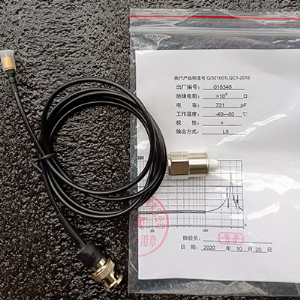Materials and constructions of piezoelectric sensors
·Piezoelectric material
Piezoelectric materials can be divided into two categories: piezoelectric crystals and piezoelectric ceramics. The most commonly used piezoelectric crystals in piezoelectric accelerometers are quartz, which has the characteristics of wide operating temperature range and stable performance. Therefore, it is often used in practical applications. The piezoelectric material used as a standard sensor. Since the piezoelectric coefficient of quartz is much lower than other piezoelectric materials, the piezoelectric material more commonly used in piezoelectric accelerometers is piezoelectric ceramics. Lead zirconate titanate in piezoelectric ceramics ( PZT) is a piezoelectric material commonly used in piezoelectric accelerometers. It is characterized by high piezoelectric coefficient, high Curie point, and various electromechanical parameters change relatively little with temperature, time and other external conditions. Although the same Piezoelectric ceramics have the same basic characteristics, but due to different manufacturing processes, the specific performance indicators of two piezoelectric ceramics using the same material may be very different. This phenomenon can be reflected by comparing typical domestic sensors and imported sensors Come out, this is the profound experience of the domestic vibration testing industry for decades.
·Structure form of sensor sensitive core
The sensitive core of the piezoelectric acceleration sensor is generally composed of a piezoelectric material and an additional mass. When the mass is accelerated, it is converted into a force proportional to the acceleration and loaded on the piezoelectric material. The piezoelectric material is on its surface. Generate a charge signal proportional to the acceleration. The characteristics of the piezoelectric material determine that the force can be a normal stress or a shear stress. The amount of charge generated by the piezoelectric material varies with the direction of the force and the position of the charge-extracting surface. According to the different stress modes of piezoelectric materials, the structure of the sensitive core of ordinary sensors generally has the following three forms:
1) Compression form – the structural form in which the piezoelectric material is compressed or stretched to generate charges. The pressure-sensitive core is a traditional acceleration sensor structure. The utility model is simple and convenient to manufacture, with high natural resonance frequency and wide frequency measurement range. The disadvantage is that it cannot effectively eliminate the influence of various interferences on the measurement signal.
2) Shear form - the structural form in which charges are generated by applying shear force to the piezoelectric material. Theoretically, the charge signal generated by the piezoelectric material under the action of shear force is less affected by external disturbances, so the shear force The shear structure has become the sensitive core of the widely used acceleration sensor. However, in the actual manufacturing process, how to ensure that the accelerometer with the shear sensitive core has a high and stable frequency measurement range is the most difficult link in the sensor manufacturing process.


